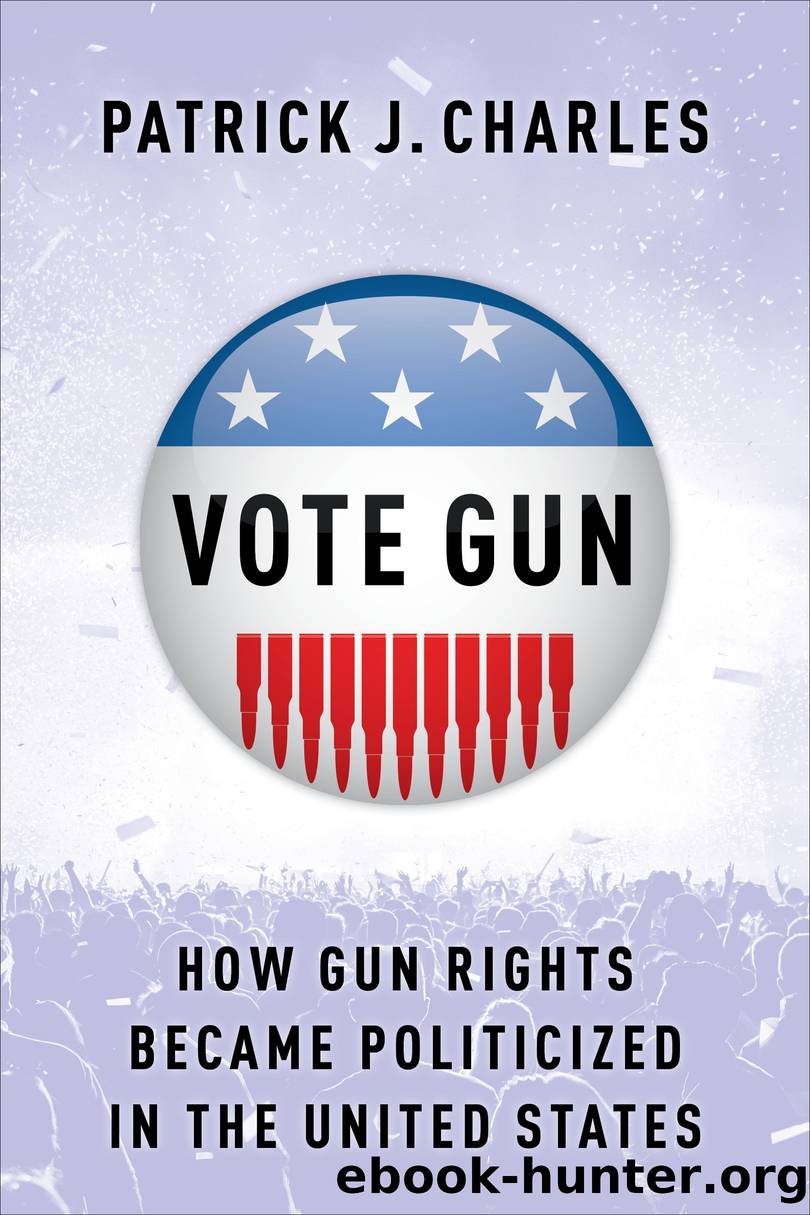Vote Gun by Patrick J. Charles;

Author:Patrick J. Charles;
Language: eng
Format: epub
Publisher: Lightning Source Inc. (Tier 3)
9
1974â1980
The Gun Rights Reformation
When President Gerald R. Ford was sworn into office, the National Rifle Association (NRA) was facing an internal crisis of sorts. Many gun rights supporters no longer considered the organization the preeminent defender of the Second Amendment. Rather, the NRA was increasingly viewed as being more concerned with expanding its own stature. There were several grievances from gun rights supporters regarding the direction the organization was headed. For one, the NRA appeared much more focused on raising funds for its new National Shooting Center in New Mexico than helping gun rights political action groups. There were also whispers that the NRA might move its headquarters away from Washington, D.C. But what was most concerning to gun rights supporters was the NRAâs insistence that it was not a lobby and therefore had no intention of getting politically involved.1
The NRAâs insistence that it was not a lobby ultimately afforded other, more extreme gun rights advocacy groups the opportunity to fill the political vacuum, causing many dedicated supporters to redirect their attention and pocketbooks elsewhere. And it did not take long for the NRA to take notice. For in early 1973, at the request of Michigan representative and longtime NRA congressional surrogate John D. Dingell, the board of directors commissioned a âfeasibilityâ study on the establishment of a separately funded âlobbying branch.â The authors of the study were asked to explore three possible roles for the lobbying branch: (1) serving as a âthink tankâ to deal with âpolitical and public efforts dealing with gun controlâ; (2) providing a âlegislative drafting and analysis serviceâ that would âscrutinize proposed firearms control legislation at Federal, State and local levels of governmentsâ; and (3) establishing a âpolitical activism serviceâ that would âorganize and mobilize sportsmen at the local and State level to lobby in the State capitals and municipal governments.â The first two roles were old hat for the NRA. Its legislative division, its public relations division, and the editors of American Rifleman had long performed these functions. The third role was also arguably old hat for the NRA. Ever since commandeering the gun rights movement in the late 1920s and early 1930s, the group had effectively organized and mobilized its state and local club affiliates to political action through grassroots advocacy. The only difference between this longstanding practice and the proposed âpolitical action serviceâ was that the latter included direct election involvement, but only on the condition that said involvement was ânonpartisan.â2
On September 22, 1973, after receiving the results of the feasibility study, the NRA board of directors elected to proceed with establishing a separately funded lobbying branch, officially named the Legislative Action Unit (LAU). In doing so, however, the board limited the âlobbyingâ role of the new branch to merely analyzing proposed firearms control legislation. The NRA urged its membership to send whatever money they could with the goal of reaching $500,000 in annual donations. NRA members were informed that the LAUâs âprime responsibilityâ was to study and analyze âanti-gun and anti-hunter legislation and recommend what response would be appropriate.
Download
This site does not store any files on its server. We only index and link to content provided by other sites. Please contact the content providers to delete copyright contents if any and email us, we'll remove relevant links or contents immediately.
The Secret History by Donna Tartt(18083)
The Social Justice Warrior Handbook by Lisa De Pasquale(11941)
Thirteen Reasons Why by Jay Asher(8416)
This Is How You Lose Her by Junot Diaz(6411)
Weapons of Math Destruction by Cathy O'Neil(5801)
Zero to One by Peter Thiel(5463)
Beartown by Fredrik Backman(5304)
The Myth of the Strong Leader by Archie Brown(5217)
The Fire Next Time by James Baldwin(4998)
How Democracies Die by Steven Levitsky & Daniel Ziblatt(4940)
Promise Me, Dad by Joe Biden(4899)
Stone's Rules by Roger Stone(4833)
100 Deadly Skills by Clint Emerson(4663)
Rise and Kill First by Ronen Bergman(4537)
A Higher Loyalty: Truth, Lies, and Leadership by James Comey(4532)
The David Icke Guide to the Global Conspiracy (and how to end it) by David Icke(4361)
Secrecy World by Jake Bernstein(4355)
The Farm by Tom Rob Smith(4306)
The Doomsday Machine by Daniel Ellsberg(4233)
